(完整版)医学专业英语试题
医学英语试题及答案

医学英语试题及答案1. 请将下列医学术语翻译成英文:A. 心脏B. 肺C. 肝脏D. 肾脏答案:A. HeartB. LungsC. LiverD. Kidneys2. 以下哪个词组表示“高血压”?A. HypertensionB. HypotensionC. HyperglycemiaD. Hypoglycemia答案:A. Hypertension3. 翻译下列句子:“患者出现急性胸痛,伴有呼吸困难。
”答案:"The patient presents with acute chest pain accompanied by difficulty breathing."4. 选择正确的医学术语填空:A. DiabetesB. HypertensionC. HypothyroidismD. Anemia他被诊断为一种慢性疾病,需要终身服用药物来控制血压。
答案:B. Hypertension5. 请解释“Cardiopulmonary Resuscitation (CPR)”的含义。
答案:Cardiopulmonary Resuscitation (CPR) 是一种紧急医疗程序,用于在心脏骤停时恢复某人的呼吸和血液循环。
6. 将下列医学缩写翻译成完整的医学术语:A. MRIB. CTC. ECGD. MRI答案:A. Magnetic Resonance ImagingB. Computed TomographyC. ElectrocardiogramD. Magnetic Resonance Imaging (重复项,应替换为其他缩写)7. 阅读下列段落并回答问题:The patient was admitted to the hospital with a diagnosis of acute appendicitis. An emergency appendectomy was performed, and the patient is now recovering in the postoperative ward.问:患者接受了哪种紧急手术?答案:患者接受了紧急阑尾切除术。
医学英语期末试题及答案
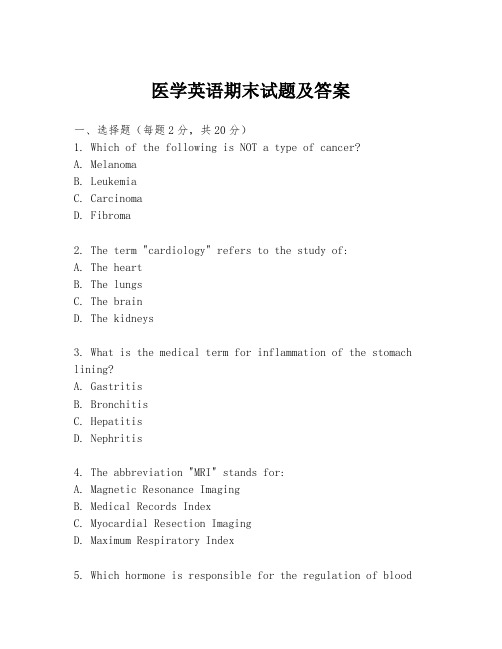
医学英语期末试题及答案一、选择题(每题2分,共20分)1. Which of the following is NOT a type of cancer?A. MelanomaB. LeukemiaC. CarcinomaD. Fibroma2. The term "cardiology" refers to the study of:A. The heartB. The lungsC. The brainD. The kidneys3. What is the medical term for inflammation of the stomach lining?A. GastritisB. BronchitisC. HepatitisD. Nephritis4. The abbreviation "MRI" stands for:A. Magnetic Resonance ImagingB. Medical Records IndexC. Myocardial Resection ImagingD. Maximum Respiratory Index5. Which hormone is responsible for the regulation of bloodsugar levels?A. InsulinB. ThyroxineC. CortisolD. Estrogen6. The process of healing a broken bone is called:A. FractureB. OsteogenesisC. OsteoporosisD. Osteolysis7. A "diagnosis" in medicine is:A. The treatment of a diseaseB. The identification of a diseaseC. The prevention of a diseaseD. The cause of a disease8. What is the medical term for a surgical incision into the chest cavity?A. LaparotomyB. ThoracotomyC. CraniotomyD. Hysterectomy9. The abbreviation "HIV" stands for:A. Human Influenza VirusB. Hepatitis Infection VirusC. Human Immunodeficiency VirusD. Hereditary Immune Virus10. A "pathogen" is:A. A type of medicationB. A disease-causing microorganismC. A symptom of a diseaseD. A preventive measure against disease二、填空题(每空1分,共10分)1. The medical term for the surgical removal of the appendix is __________.2. The study of the nervous system is known as __________.3. A condition characterized by high levels of blood sugar is called __________.4. The process of the body fighting off pathogens is known as __________.5. The abbreviation for the common cold is __________.6. The medical term for inflammation of the heart muscle is __________.7. The medical specialty dealing with the urinary system is __________.8. A person who specializes in the study and treatment of cancer is called an __________.9. The abbreviation for the human papillomavirus is__________.10. A medical condition where the body's immune system attacks its own tissues is known as __________.三、简答题(每题5分,共20分)1. Explain the difference between a virus and a bacterium.2. Describe the function of the thyroid gland.3. What is the purpose of vaccination?4. Define the term "epidemic" and give an example.四、翻译题(每题5分,共20分)1. 翻译以下医学术语:"急性阑尾炎"2. 翻译以下医学术语:"慢性支气管炎"3. 翻译以下医学术语:"高血压"4. 翻译以下医学术语:"糖尿病"五、病例分析题(每题10分,共20分)1. 患者,男性,45岁,主诉胸痛,呼吸困难。
(完整版)医学专业英语试题
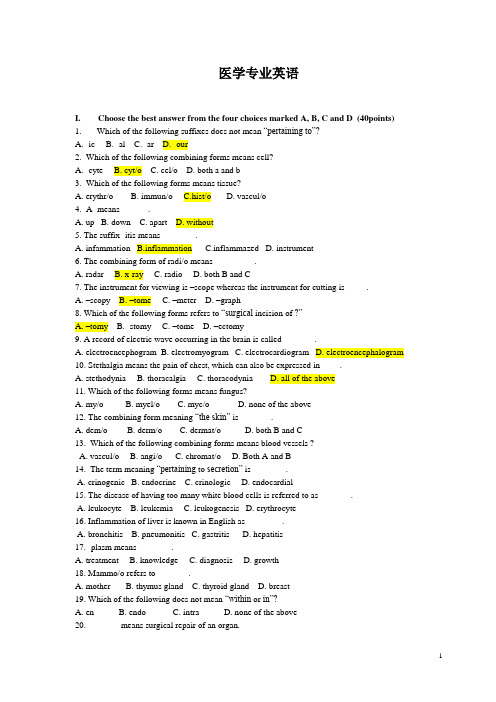
医学专业英语I. Choose the best answer from the four choices marked A, B, C and D (40points)1. Which of the following suffixes does not mean “pertaining to”?A. -icB. -alC. -arD. -our2. Which of the following combining forms means cell?A. -cyteB. cyt/oC. cel/oD. both a and b3. Which of the following forms means tissue?A. erythr/oB. immun/oC.hist/oD. vascul/o4. A- means ______.A. upB. downC. apartD. without5. The suffix -itis means _______ .A. infammationB.inflammationC.inflammazedD. instrument6. The combining form of radi/o means _________.A. radarB. x-rayC. radioD. both B and C7. The instrument for viewing is –scope whereas the instrument for cutting is_____.A. –scopyB. –tomeC. –meterD. –graph8. Which of the following forms refers to “surgical incision of ?”A. –tomyB. -stomyC. –tomeD. –ectomy9. A record of electric wave occurring in the brain is called _______.A. electroencephogramB. electromyogramC. electrocardiogramD. electroencephalogram10. Stethalgia means the pain of chest, which can also be expressed in ____.A. stethodyniaB. thoracalgiaC. thoracodyniaD. all of the above11. Which of the following forms means fungus?A. my/oB. myel/oC. myc/oD. none of the above12. The combining form meaning “the skin” is _______.A. dem/oB. derm/oC. dermat/oD. both B and C13. Which of the following combining forms means blood vessels ?A. vascul/oB. angi/oC. chromat/oD. Both A and B14. The term meaning “pertaining to secretion” is _______ .A. crinogenicB. endocrineC. crinologicD. endocardial15. The disease of having too many white blood cells is referred to as _______.A. leukocyteB. leukemiaC. leukogenesisD. erythrocyte16. Inflammation of liver is known in English as ________.A. bronchitisB. pneumonitisC. gastritisD. hepatitis17. -plasm means _______.A. treatmentB. knowledgeC. diagnosisD. growth18. Mammo/o refers to _______.A. motherB. thymus glandC. thyroid glandD. breast19. Which of the following does not mean “within or in”?A. en-B. endo-C. intra-D. none of the above20. _______ means surgical repair of an organ.A. phag/oB. –plasmC. –plastyD. –pathy21. Spir/o is a combining form meaning ______.A. seeB. sightC. breathD. sport22. Inflammation of lungs is known as _______.A. pneumonitisB. pneumoniaC. pulmonitisD. All of the above23. Which of the following forms means “p rotection or safe” ?A. immun/oB. lymph/oC. erythr/oD. None of the above24. Cardiopathy means _________.A. heart failureB. heart diseaseC. brain diseaseD. skeletal disease25.Which of the following combining forms does not refer to an organ?A. hepat/oB. gastr/oC. psych/oD. nephr/o26. The color of something best expressed in medical terminology is _______.A. chrom/oB. chromomat/oC. chramat/oD. Both A and B27. Which of the following means “instrument for measuring”?A. -graphB. -tomeC. –meterD. -scope28. Bi- means ______.A. lifeB. twoC. acrossD. Both A and B29. The form meaning arteries is ________.A. arter/oB. arteri/oC. arthr/oD.artheri/o30. The prefix with the meaning of bad is ______.A. mal-B. dys-C. polio-D. Both A and B31. The flesh is expressed in the combining form of _______.A. top/oB. ten/oC.thym/oD. sarc/o32. The combining vowel for angitis is ____________.A. aB. oC. eD.i33. Hypo- means having _______ of something.A. too much or too highB. too little or too lowC. overD. below34. Morph/o means ______.A. manyB. maxillaeC. shapeD. head35. “Pertaining to nourishment or development” is expressed in _________.A. –tropyB. –trophyC.- tropicD.-trophic36. The process of recording sth is expressed in _________.A. -graphB. -gramC. -graphyD.-scope37. The formation of blood is also known as ______.A. hematopoiesisB. hemopoiesisC.homopoiesisD. both A and B38. Because the strands are readily stained with dyes, they are called_______.A. chromosomesB. protoplasmsC. cytoplasmsD.chromatins39.The science that deals with cells on the smallest structural and functional level is called _____.A. biologyB. microbiologyC. homostasisD. molecular biology40. An instrument for measuring the cell counts of red blood cells is an _______.A. erythrocyteB. erythrogenesisC. erythrocytometerD. erythrocytographII. Find the best answer to the following abbreviations. (10 points)41. SARSA. Serious Acute Respiratary SyndromeB. Severe Acute Respiration SystemC. Severe Acute Respiratory SyndromeD. Severe Acute Respiratary Syndrome42. T.BA. tuberclosisB. tubercluosisC. tubaclosisD. tuberculosis43. IgA.immunoglobinB. immunogloblinC. immunoglobulinD. immunoglubin44. RNAA. ribonuclear acidB. ribanucleic acidC. ribanucleic acidD. ribonucleic acidGA. ultrosonograhyB. ultrasonograhyC. ultrosonographyD. ultrasonography46.ECGA. electrocardiogramB. electrocardiographyC. electroencephogramD. electroencephalogram47. CTA. computed tomograhyB. computed tomographyC. computerized tomograhyD. computerized tom ography48. MRIA. Magnetic resononce imageB. Magnetic resonance imageC. Magnetic resononce imagingD. Magnetic resonance imaging49.VDA. varied diseaseB. venareal diseaseC. venereal diseaseD. vocal disease50. GIA. gastrointral tractB. gastrointervention tractC. gastrointestinal tractD. gastrointersectional tract III. Find the best answer to the following translations. (10 points)51. 心血管疾病A. cardiavasclar diseaseB. cardiavascular diseaseC. cardiovasclar diseaseD. cardiovascular dise ase52.随意肌A. voluntary muscleB. involuntary muscleC. smooth muscleD. cardiac muscle53 脉冲信号A. pulseB. impulseC. impulsiveD. pulsive54. 转换A. transformationB. transactionC. transmuteD. transmission55.功能失调A. malfunctionB. dysfunctionC. maloperationD. disoperation56. 局部化的感染A. local infectionB. localized infectionC. local inflammationD. localized inflammation57.乐观的预后A. optimistic pregnosisB. optimistic prognosisC. pessimistic pregnosisD. pessimistic prognosis58. 光纤技术A. optic fiber technologyB. fiber optic techonologyC. fiber optic technologyD. optic fiber techonology59. 肌肉收缩A. muscle contractionB. muscular contractionC..musclar contractionD. Both A and B60. 血供A. supply blood B. blood supply C. protein molecule D. extensorIV. Translate the following into Chinese. (40 points)61. Hundreds of different diseases exist. Each has its own particular set of symptoms and signs, clues that enable a physician to diagnose the problem. A symptom is something a patient can detect, such as fever, bleeding, or pain. A sign is something a doctor can detect, such as a swollen blood vessel or a n enlarged internal body organ.62. All cells consist of protoplasm, the “living jelly”. The protoplasm of a typical cell forms three vitalparts --- the cell membrane, the cytoplasm, and the nucleus. The membrane encloses the other cell st ructures. Much of the chemical work of the cell is done in the cytoplasm, which surrounds the nucle us. The nucleus, enclosed by its own membrane, is the control center of the cell.1.D2.B3. C4. D5. B6. B7. B8.A9. D 10.D11.C 12.D 13. D 14.A 15. B 16. D 17. D 18.D 19. D 20.C21.C 22.D 23. A 24. B 25. C 26. A 27. C 28.B 29. B 30.D31.D 32.B 33. B 34.C 35. D 36. C 37. D 38.D 39. D 40.C41.C 42.D 43. C 44. D 45. D 46. A 47. B 48.D 49. C 50.C51.D 52.A 53. B 54.B 55. A 56. B 57.B 58.C 59. D 60.B61. 疾病有成百上千种。
(完整版)医学专业英语
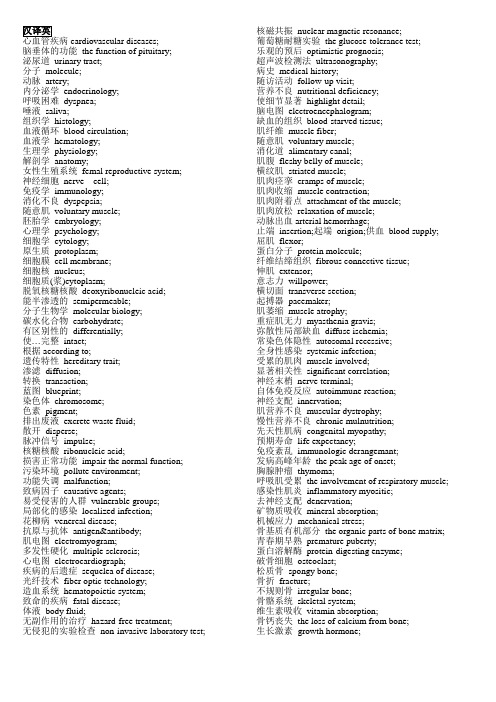
cardiovascular diseases;脑垂体的功能the function of pituitary;泌尿道urinary tract;分子molecule;动脉artery;内分泌学endocrinology;呼吸困难dyspnea;唾液saliva;组织学histology;血液循环blood circulation;血液学hematology;生理学physiology;解剖学anatomy;女性生殖系统femal reproductive system;神经细胞nerve cell;免疫学immunology;消化不良dyspepsia;随意肌voluntary muscle;胚胎学embryology;心理学psychology;细胞学cytology;原生质protoplasm;细胞膜cell membrane;细胞核nucleus;细胞质(浆)cytoplasm;脱氧核糖核酸deoxyribonucleic acid;能半渗透的semipermeable;分子生物学molecular biology;碳水化合物carbohydrate;有区别性的differentially;使…完整intact;根据according to;遗传特性hereditary trait;渗滤diffusion;转换transaction;蓝图blueprint;染色体chromosome;色素pigment;排出废液excrete waste fluid;散开disperse;脉冲信号impulse;核糖核酸ribonucleic acid;损害正常功能impair the normal function;污染环境pollute environment;功能失调malfunction;致病因子causative agents;易受侵害的人群vulnerable groups;局部化的感染localized infection;花柳病venereal disease;抗原与抗体antigen&antibody;肌电图electromyogram;多发性硬化multiple sclerosis;心电图electrocardiograph;疾病的后遗症sequelea of disease;光纤技术fiber optic technology;造血系统hematopoietic system;致命的疾病fatal disease;体液body fluid;无副作用的治疗hazard-free treatment;无侵犯的实验检查non-invasive laboratory test; 核磁共振nuclear magnetic resonance;葡萄糖耐糖实验the glucose-tolerance test;乐观的预后optimistic prognosis;超声波检测法ultrasonography;病史medical history;随访活动follow-up visit;营养不良nutritional deficiency;使细节显著highlight detail;脑电图electroencephalogram;缺血的组织blood-starved tissue;肌纤维muscle fiber;随意肌voluntary muscle;消化道alimentary canal;肌腹fleshy belly of muscle;横纹肌striated muscle;肌肉痉挛cramps of muscle;肌肉收缩muscle contraction;肌肉附着点attachment of the muscle;肌肉放松relaxation of muscle;动脉出血arterial hemorrhage;止端insertion;起端origion;供血blood supply; 屈肌flexor;蛋白分子protein molecule;纤维结缔组织fibrous connective tissue;伸肌extensor;意志力willpower;横切面transverse section;起搏器pacemaker;肌萎缩muscle atrophy;重症肌无力myasthenia gravis;弥散性局部缺血diffuse ischemia;常染色体隐性autosomal recessive;全身性感染systemic infection;受累的肌肉muscle involved;显著相关性significant correlation;神经末梢nerve terminal;自体免疫反应autoimmune reaction;神经支配innervation;肌营养不良muscular dystrophy;慢性营养不良chronic mulnutrition;先天性肌病congenital myopathy;预期寿命life expectancy;免疫紊乱immunologic derangemant;发病高峰年龄the peak age of onset;胸腺肿瘤thymoma;呼吸肌受累the involvement of respiratory muscle; 感染性肌炎inflammatory myositic;去神经支配denervation;矿物质吸收mineral absorption;机械应力mechanical stress;骨基质有机部分the organic parts of bone matrix; 青春期早熟premature puberty;蛋白溶解酶protein-digesting enzyme;破骨细胞osteoclast;松质骨spongy bone;骨折fracture;不规则骨irregular bone;骨骼系统skeletal system;维生素吸收vitamin absorption;骨钙丧失the loss of calcium from bone;生长激素growth hormone;骺软骨epiphyseal cartilage;镁缺乏magnesium deficiency;成骨细胞osteoblast;密质骨compact bone;骨髓腔marrow cavity;红骨髓red marrow;软骨内骨化endochondral ossification;矫形学orthopedics;闭合性骨折closed fracture;骨代谢疾病metabolic bone disease;雌激素替代疗法estrogen replacement therapy; 肾上腺皮质adrenal cortex;佝偻病rickets;骨肉瘤osteosarcoma;软骨肉瘤chondrosarcoma;止痛relieve pain;类风湿关节炎rheumatoid arthritis;骨髓炎osteomyelitis;开放性骨折open fracture;骨质疏松症osteoporosis;营养缺乏nutritional deficiency;骨软化症osteomalocia;听力丧失hearing lose;恶性肿瘤malignant tumor;关节炎arthritis;抗炎剂anti-inflammatory drugs;痛风gout;牙周组织periodontium;唾液腺salivary glands;口腔oral cavity;升结肠ascending colon;贲门括约肌cardiac sphincter;乳化作用emulsification;消化道alimentary tract;脾弯曲splenic flexure;锥形的突起cone-shaped papillae;似袋状的器官pouch-like organ;会厌epiglottis;十二指肠duodenum;乙状结肠sigmoid colon;幽门括约肌pyloric sphincter;舌下腺sublingual gland;蠕动peristalsis;下颌下腺submandibular gland;解毒作用detoxification;回盲瓣ileocecal valve;胰岛素insulin;穿孔perforation;溃疡性结肠炎ulcerative colitis;纤维变性fibrosis;阑尾炎appendicitis;胃十二指肠吻合术gastroduodenostomy;直肠镜proctoscope;裂孔疝hiatal hernia;造影剂contrast medium;代偿失调decompensation;胆石病choletithiasis;内窥镜检查endoscopy;胆囊切除术cholecystectomy;憩室炎diverticulitis;麻痹性肠梗阻paralytic ileus; 胆绞痛biliary colic;一个系列的 a spectrum of;副鼻窦paranasal sinus;口咽oropharynx;脊椎动物verterbrate animal;肺泡alveolus;二氧化碳carbon dioxide;肺换气不足hypoventilation;横膈膜神经phrenic nerve;双重折叠的double folded;威慑物deterrent;润滑液lubricating fluid;滞痰stagnant sputum;食管esophagus;纵隔mediastinum;哺乳动物mammal;碱中毒alkalosis;迷宫labyrinth;污染物质pollutant;脑干brainstem;上皮,上皮细胞epithelium;刺激物irritant;利尿剂duretics;大叶性肺炎lobar pneumonia;疾病的鉴别differentiation of disease;破坏性的损坏destructive damage;痰性咳嗽productive cough;共存coexist;医学文献medical literatures;咯血nemoptysis;渗出物,渗出液exudate;痰液phlegm;气促,气短breathless;无症状的asymptomatic;吸烟者晨咳morning cigarette cough;肺弹性回缩elastic recoil;反复发作recurrent episodes;有毒刺激物质nonxious agents;连续三年successive 3 years;交叉重复crossover;互相排除的mutually exclusive;小气道闭塞obliteration of small airway;主动脉弓aortic arch;胸主动脉thoracic aorta;舒张压diastolic pressure;腹主动脉abdominal aorta;收缩压systolic pressure;脊柱vertebral colum;毫米汞柱mmHg;半月形的semilunar;最里层的innermost;升主动脉ascending aorta;二尖瓣bicuspid valve;体循环systemic circuit;上腔静脉superior vena cava下腔静脉inferior vena cava;心肌myocardium;心内膜endocadium;细分;分支subdivision;心外膜epicardium;小动脉arteriole;心包pericardium;全血细胞减少pancytopenia;网织红细胞reticulocyte;自身免疫的autoimmune;危及生命的life-threatening;凝结cougulation;血小板减少thrombocytopenia;免疫缺陷immunodeficiency;功能紊乱dysfunction;活疫苗live vaccine;移植物对宿主的反应graft-versus-host reaction;血友病hemophilia;素质diathesis;巨成红细胞megaloblast;自发病,特发病idiopathic;弥散性血管内凝血disseminated intravascular coagulation;instrinsic;appendic/o>appendix阑尾炎2bil/i/rubin bil/i>bile胆红素3chondr/o/sarc/oma chrondr/o >cartilage ; sarc/o >flesh 软骨肉瘤4chol/sterol chol/e > bile, gall胆固醇5bucc/al bucc/o > bucca口腔的;颊的6crani/al crani/o > skull颅的,颅侧的7colon/o/scope colon/o > colon结肠镜8sigmoid/o/scope sigmoid/o > sigmoid colon乙状结肠镜9inter/cost/al cost/o > rib肋间的10dent/in dent/o > teeth牙质11epi/gastr/ic gastr/o > stomach胃上部的,腹上部的12enter/itis enter/o > small intestine肠炎13arthr/itis arthr/i > joint关节炎14bronch/o/genic bronch/o > bronchus支气管原的15cec/um cec/o > cecum盲肠16sub/lingu/al lingu/o > tongue舌下的17gingiv/itis gingiv/o > gum牙龈炎18nas/o/gastr/ic gas/o > nose gastr/o > stomach鼻饲的19hypo/pharyng/eal pharyng/o > pharynx下咽的20diverticul/osis diverticul/o > diverticulum憩室病21ile/o/stomy ile/o > ileum回肠造口术22chol/e/cyst/ectomy chol/e > bile; cyst/o > sac胆囊切除术23abdomin/al abdomin/o > abdomen腹部的24pneumon/ia pneumon/o > lung肺炎25thorac/ic thorac/o > pleural cavity ,chestcavity 胸腔的26duoden/um deoden/o > duodenum十二指肠27laryng/o/pharynx larygn/o > larynx pharyng/o >pharynx 咽喉28vertebr/ate vertebr/o > back bone脊椎动物29oste/o/myel/itis oste/o > bone;myel/o > bonemarrow 骨髓炎30pancreat/ic pancreat/o>pancreas胰腺炎31angi/o/plasty angio>vessels血管成形术32extra/o/cular extra>outside细胞外的33tendon/ous ten>tendon肌腱的34mamm/o/graphy mamm>breast乳房X线检查术35electr/o/my/o/gram electr>electricity,my>muscle肌电图36erythr/o/cyte eryth>red红细胞37hem/o/globin globin>protein血红蛋白38prot/o/plasm prot>first原生质39urin/ary ary>pertaining to泌尿道的40neur/o/pathy neur>nerve神经疾病41lymph/atic lymph>lymph淋巴的42my/o/fiber my>muscle肌纤维43pelv/ic pelv>pelvic bone盆骨44hepat/itis itis>inflammation肝炎45fibr/ous fibr>fiber纤维的46embry/o/logy embry>embryo胚胎学47leuk/emia emia>blood condition白血病48electr/o/cardi/o/graph graph>instrument ofrecording 心电图仪49dermat/o/my/o/sitis dermat>skin皮肤炎50thym/ectomy ectomy>surgical exasion orremoval of 胸腺切除术51cyt/o/plasm cyt>cell细胞浆52isch/emia isch> to hold back局部缺血53steth/o/scope stech> the chest 听诊器54pulmon/ary pulmon>lung 肺的55sarc/o/plasm plasm>formation growth or substance of formation 肌浆56chrom/o/some some>body 染色体57vascul/ar vascul>blood vessel5岁小男孩。
医护英语考试试题及答案
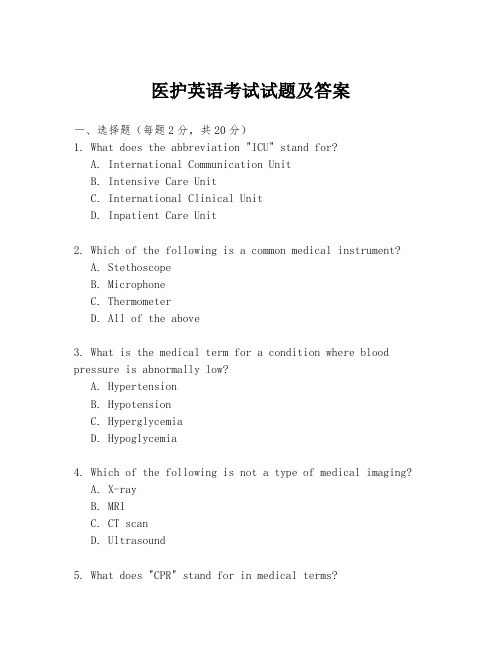
医护英语考试试题及答案一、选择题(每题2分,共20分)1. What does the abbreviation "ICU" stand for?A. International Communication UnitB. Intensive Care UnitC. International Clinical UnitD. Inpatient Care Unit2. Which of the following is a common medical instrument?A. StethoscopeB. MicrophoneC. ThermometerD. All of the above3. What is the medical term for a condition where blood pressure is abnormally low?A. HypertensionB. HypotensionC. HyperglycemiaD. Hypoglycemia4. Which of the following is not a type of medical imaging?A. X-rayB. MRIC. CT scanD. Ultrasound5. What does "CPR" stand for in medical terms?A. Cardiopulmonary ResuscitationB. Chronic Pain ReliefC. Clinical Pathology ReportD. Continuous Positive Respiration6. What is the meaning of the term "anemia"?A. A condition characterized by high levels of red blood cellsB. A condition characterized by low levels of red blood cellsC. A condition characterized by high levels of white blood cellsD. A condition characterized by low levels of white blood cells7. Which of the following is a measure to prevent infectionin a hospital setting?A. Hand hygieneB. Smoking indoorsC. Sharing needlesD. None of the above8. What is the medical term for a surgical procedure to remove a tumor?A. AmputationB. AppendectomyC. ExcisionD. Incision9. Which of the following is a common symptom of the flu?A. Dry coughB. InsomniaC. HyperactivityD. Loss of appetite10. What does "HIV" stand for?A. Hepatitis Infection VirusB. Human Immunodeficiency VirusC. High Intensity VirusD. Hormone Infection Virus二、填空题(每题1分,共10分)11. A healthcare professional who specializes in surgery is called a _______.12. The process of cleaning a wound is known as _______.13. The abbreviation "BP" is commonly used to refer to_______.14. A person with a medical condition that requires ongoing treatment is referred to as a _______.15. The medical term for a broken bone is _______.16. The first step in treating a burn is to _______ the area.17. The abbreviation "OT" stands for _______.18. Aspirin is often used as an _______ for pain relief.19. The medical term for a severe allergic reaction is_______.20. The abbreviation "A&E" refers to the _______ departmentin a hospital.三、简答题(每题5分,共30分)21. Explain the purpose of a blood transfusion.22. Describe the role of a nurse in a hospital setting.23. What are the signs of a heart attack?24. Discuss the importance of patient confidentiality in healthcare.四、阅读理解(每题5分,共20分)阅读以下短文,回答下列问题。
医学专业英语考试专题 含答案

• A. see B. sight C. breath
D. sport
2020/3/23
• D22. Inflammation of lungs is known as _______.
• A. pneumonitis All of the above
B. pneumonia
C. pulmonitis D.
• 37. The formation of blood is also known as ____
__.
• A. hematopoiesis B. hemopoiesis poiesis D. both A and B
C.homo
• D38. Because the strands are readily stained with dyes, they are called_______.
cul/o
2020/3/23
• D4. A- means ______. • A. up B. down C. apart D. without • B5. The suffix -itis means _______ . • A. infammation B.inflammation • C.inflammazed D. instrument • B6. The combining form of radi/o means ______
• B2. Which of the following combining forms me ans cell?
• A. -cyte B. cyt/o C. cel/o D. both a and b • C3. Which of the following forms means tissue? • A. erythr/o B. immun/o C.hist/o D. vas
医学统考英语试题及答案
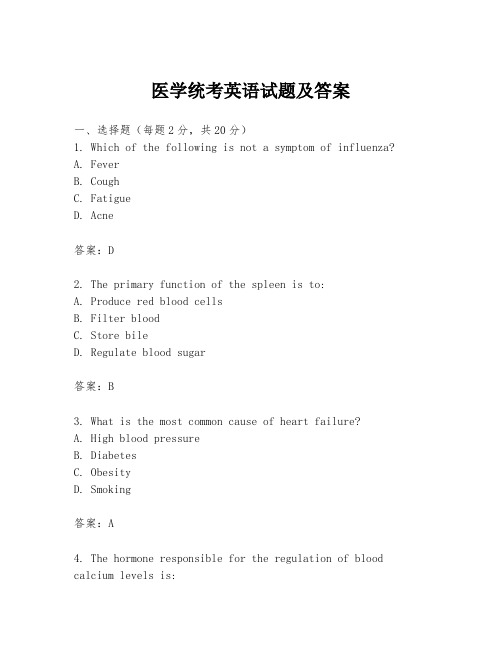
医学统考英语试题及答案一、选择题(每题2分,共20分)1. Which of the following is not a symptom of influenza?A. FeverB. CoughC. FatigueD. Acne答案:D2. The primary function of the spleen is to:A. Produce red blood cellsB. Filter bloodC. Store bileD. Regulate blood sugar答案:B3. What is the most common cause of heart failure?A. High blood pressureB. DiabetesC. ObesityD. Smoking答案:A4. The hormone responsible for the regulation of blood calcium levels is:A. InsulinB. Thyroid hormoneC. Parathyroid hormoneD. Adrenaline答案:C5. Which of the following is a risk factor for developingtype 2 diabetes?A. Regular exerciseB. Healthy dietC. Family history of diabetesD. Low stress levels答案:C6. The process of cell division that results in two identical cells with the same genetic material is called:A. MitosisB. MeiosisC. ApoptosisD. Cytokinesis答案:A7. Which of the following is not a type of autoimmune disease?A. Rheumatoid arthritisB. LupusC. Multiple sclerosisD. Parkinson's disease答案:D8. The main function of the liver is to:A. Produce insulinB. Filter bloodC. Detoxify the bodyD. Regulate body temperature答案:C9. The most common type of cancer in men is:A. Lung cancerB. Prostate cancerC. Colon cancerD. Skin cancer答案:B10. The hormone that stimulates the uterus to contract during childbirth is:A. OxytocinB. EstrogenC. ProgesteroneD. Cortisol答案:A二、填空题(每题2分,共20分)1. The respiratory system is responsible for the exchange of _______ and _______.答案:oxygen, carbon dioxide2. The largest organ in the human body is the _______.答案:skin3. The process of digestion begins in the _______.答案:mouth4. The hormone that stimulates the growth and development of the female reproductive system is _______.答案:estrogen5. The most common type of cancer in women is _______.答案:breast cancer6. The heart is divided into four chambers: two atria and two _______.答案:ventricles7. The nervous system is divided into the central nervous system and the _______ nervous system.答案:peripheral8. The primary function of the kidneys is to _______ the blood and produce urine.答案:filter9. The hormone that regulates blood sugar levels is _______. 答案:insulin10. The most common cause of liver cancer is chronic _______. 答案:hepatitis三、简答题(每题10分,共20分)1. Explain the role of the lymphatic system in the body.答案:The lymphatic system plays a crucial role in maintaining the body's fluid balance and immune function. It is responsible for the circulation of lymph, a fluid containing white blood cells, throughout the body. This system helps to remove waste products, bacteria, and other foreign substances from the tissues and returns the excess fluid to the bloodstream. Additionally, the lymphatic system is integral to the immune response as it contains lymph nodes that filter out harmful substances and produce lymphocytes, which are essential for fighting infections.2. Describe the process of blood clotting.答案:Blood clotting, also known as coagulation, is a complex process that prevents excessive bleeding when a blood vessel is injured. It involves several steps: First, the damaged blood vessel constricts to reduce blood flow. Platelets, small cell fragments in the blood, adhere to the site of injury and aggregate to form a plug. Meanwhile, a series of clotting factors in the blood are activated in a cascade, leading to the conversion of fibrinogen into fibrin. Thefibrin forms a mesh that traps the platelet plug, creating a stable clot. Finally, once the blood vessel has healed, the clot is dissolved by the action of plasmin, an enzyme that breaks down fibrin.。
医学英语考试试题及答案

医学英语考试试题及答案一、选择题(每题1分,共10分)1. Which of the following is a common symptom of the common cold?A. FeverB. CoughC. Both A and BD. Neither A nor B2. The term "cardiology" refers to the study of which organ?A. LiverB. HeartC. LungsD. Kidneys3. What does the abbreviation "MRI" stand for?A. Magnetic Resonance ImagingB. Medical Research InstituteC. Multiple Response IndicatorD. Medical Radiology Institute4. The process of healing a wound is known as:A. InflammationB. RegenerationC. ResectionD. Reabsorption5. Which of the following is not a type of cancer?A. LeukemiaB. MelanomaC. SarcomaD. Fibromyalgia6. The term "diabetes" is related to the body's inability to:A. Excrete wasteB. Regulate blood sugar levelsC. Maintain body temperatureD. Clot blood7. The abbreviation "HIV" stands for:A. Human Immunodeficiency VirusB. High Intensity VirusC. Hemorrhagic Influenza VirusD. Hepatitis Infection Virus8. A "pathogen" is an agent that can cause:A. DiseaseB. GrowthC. RegenerationD. Immunity9. The medical term "anemia" refers to a deficiency of:A. CalciumB. IronC. Vitamin CD. Potassium10. The abbreviation "WHO" stands for:A. World Health OrganizationB. World Health OrganizationalC. World Health OperationsD. World Health Oversight答案:1. C2. B3. A4. B5. D6. B7. A8. A9. B10. A二、填空题(每空1分,共10分)1. The medical term for inflammation of the lungs is ______.答案:Pneumonia2. A person with a condition that causes excessive thirst and urination is said to have ______.答案:Diabetes3. The study of the nervous system is known as ______.答案:Neurology4. A surgical procedure to remove a diseased organ is called a/an ______.答案:Resection5. The process by which the body destroys and removes waste and foreign substances is called ______.答案:Immunity6. A medical condition characterized by high levels of fat in the blood is known as ______.答案:Hyperlipidemia7. The abbreviation for the medical term "arteriosclerosis" is ______.答案:AS8. A deficiency in the number or quality of red blood cells is referred to as ______.答案:Anemia9. The medical term for the surgical removal of a tumor is______.答案:Excision10. The study of the structure and function of the human body is called ______.答案:Anatomy三、简答题(每题5分,共20分)1. What is the difference between a virus and a bacterium?答案:A virus is a small infectious agent that can only replicate inside the living cells of an organism, while a bacterium is a single-celled microorganism that can live independently and reproduce by binary fission.2. Explain the concept of "homeostasis" in the body.答案:Homeostasis refers to the ability of an organism to maintain a constant internal environment despite changes in external conditions. This includes the regulation of body temperature, pH, and chemical composition to ensure optimal functioning of cells and organs.3. What is the role of the thyroid gland in the body?答案:The thyroid gland is an endocrine gland that produces hormones, such as thyroxine (T4) andtriiodothyronine (T3), which regulate the body's metabolism, growth, and development.4. Describe the function of the respiratory system.答案:The respiratory system is responsible for the exchange of gases, primarily oxygen and carbon dioxide, between the body and the environment. It includes the process of inhalation, where oxygen is taken in, and exhalation, where carbon dioxide is expelled.四、翻译题(每题5分,共20分)1. 请将以下医学术语翻译成中文:"Cardiopulmonary resuscitation"答案:心肺复苏2. 请将。
- 1、下载文档前请自行甄别文档内容的完整性,平台不提供额外的编辑、内容补充、找答案等附加服务。
- 2、"仅部分预览"的文档,不可在线预览部分如存在完整性等问题,可反馈申请退款(可完整预览的文档不适用该条件!)。
- 3、如文档侵犯您的权益,请联系客服反馈,我们会尽快为您处理(人工客服工作时间:9:00-18:30)。
医学专业英语I. Choose the best answer from the four choices marked A, B, C and D (40points)1. Which of the following suffixes does not mean “pertaining to”?A. -icB. -alC. -arD. -our2. Which of the following combining forms means cell?A. -cyteB. cyt/oC. cel/oD. both a and b3. Which of the following forms means tissue?A. erythr/oB. immun/oC.hist/oD. vascul/o4. A- means ______.A. upB. downC. apartD. without5. The suffix -itis means _______ .A. infammationB.inflammationC.inflammazedD. instrument6. The combining form of radi/o means _________.A. radarB. x-rayC. radioD. both B and C7. The instrument for viewing is –scope whereas the instrument for cutting is_____.A. –scopyB. –tomeC. –meterD. –graph8. Which of the following forms refers to “surgical incision of ?”A. –tomyB. -stomyC. –tomeD. –ectomy9. A record of electric wave occurring in the brain is called _______.A. electroencephogramB. electromyogramC. electrocardiogramD. electroencephalogram10. Stethalgia means the pain of chest, which can also be expressed in ____.A. stethodyniaB. thoracalgiaC. thoracodyniaD. all of the above11. Which of the following forms means fungus?A. my/oB. myel/oC. myc/oD. none of the above12. The combining form meaning “the skin” is _______.A. dem/oB. derm/oC. dermat/oD. both B and C13. Which of the following combining forms means blood vessels ?A. vascul/oB. angi/oC. chromat/oD. Both A and B14. The term meaning “pertaining to secretion” is _______ .A. crinogenicB. endocrineC. crinologicD. endocardial15. The disease of having too many white blood cells is referred to as _______.A. leukocyteB. leukemiaC. leukogenesisD. erythrocyte16. Inflammation of liver is known in English as ________.A. bronchitisB. pneumonitisC. gastritisD. hepatitis17. -plasm means _______.A. treatmentB. knowledgeC. diagnosisD. growth18. Mammo/o refers to _______.A. motherB. thymus glandC. thyroid glandD. breast19. Which of the following does not mean “within or in”?A. en-B. endo-C. intra-D. none of the above20. _______ means surgical repair of an organ.A. phag/oB. –plasmC. –plastyD. –pathy21. Spir/o is a combining form meaning ______.A. seeB. sightC. breathD. sport22. Inflammation of lungs is known as _______.A. pneumonitisB. pneumoniaC. pulmonitisD. All of the above23. Which of the following forms means “p rotection or safe” ?A. immun/oB. lymph/oC. erythr/oD. None of the above24. Cardiopathy means _________.A. heart failureB. heart diseaseC. brain diseaseD. skeletal disease25.Which of the following combining forms does not refer to an organ?A. hepat/oB. gastr/oC. psych/oD. nephr/o26. The color of something best expressed in medical terminology is _______.A. chrom/oB. chromomat/oC. chramat/oD. Both A and B27. Which of the following means “instrument for measuring”?A. -graphB. -tomeC. –meterD. -scope28. Bi- means ______.A. lifeB. twoC. acrossD. Both A and B29. The form meaning arteries is ________.A. arter/oB. arteri/oC. arthr/oD.artheri/o30. The prefix with the meaning of bad is ______.A. mal-B. dys-C. polio-D. Both A and B31. The flesh is expressed in the combining form of _______.A. top/oB. ten/oC.thym/oD. sarc/o32. The combining vowel for angitis is ____________.A. aB. oC. eD.i33. Hypo- means having _______ of something.A. too much or too highB. too little or too lowC. overD. below34. Morph/o means ______.A. manyB. maxillaeC. shapeD. head35. “Pertaining to nourishment or development” is expressed in _________.A. –tropyB. –trophyC.- tropicD.-trophic36. The process of recording sth is expressed in _________.A. -graphB. -gramC. -graphyD.-scope37. The formation of blood is also known as ______.A. hematopoiesisB. hemopoiesisC.homopoiesisD. both A and B38. Because the strands are readily stained with dyes, they are called_______.A. chromosomesB. protoplasmsC. cytoplasmsD.chromatins39.The science that deals with cells on the smallest structural and functional level is called _____.A. biologyB. microbiologyC. homostasisD. molecular biology40. An instrument for measuring the cell counts of red blood cells is an _______.A. erythrocyteB. erythrogenesisC. erythrocytometerD. erythrocytographII. Find the best answer to the following abbreviations. (10 points)41. SARSA. Serious Acute Respiratary SyndromeB. Severe Acute Respiration SystemC. Severe Acute Respiratory SyndromeD. Severe Acute Respiratary Syndrome42. T.BA. tuberclosisB. tubercluosisC. tubaclosisD. tuberculosis43. IgA.immunoglobinB. immunogloblinC. immunoglobulinD. immunoglubin44. RNAA. ribonuclear acidB. ribanucleic acidC. ribanucleic acidD. ribonucleic acidGA. ultrosonograhyB. ultrasonograhyC. ultrosonographyD. ultrasonography46.ECGA. electrocardiogramB. electrocardiographyC. electroencephogramD. electroencephalogram47. CTA. computed tomograhyB. computed tomographyC. computerized tomograhyD. computerized tom ography48. MRIA. Magnetic resononce imageB. Magnetic resonance imageC. Magnetic resononce imagingD. Magnetic resonance imaging49.VDA. varied diseaseB. venareal diseaseC. venereal diseaseD. vocal disease50. GIA. gastrointral tractB. gastrointervention tractC. gastrointestinal tractD. gastrointersectional tract III. Find the best answer to the following translations. (10 points)51. 心血管疾病A. cardiavasclar diseaseB. cardiavascular diseaseC. cardiovasclar diseaseD. cardiovascular dise ase52.随意肌A. voluntary muscleB. involuntary muscleC. smooth muscleD. cardiac muscle53 脉冲信号A. pulseB. impulseC. impulsiveD. pulsive54. 转换A. transformationB. transactionC. transmuteD. transmission55.功能失调A. malfunctionB. dysfunctionC. maloperationD. disoperation56. 局部化的感染A. local infectionB. localized infectionC. local inflammationD. localized inflammation57.乐观的预后A. optimistic pregnosisB. optimistic prognosisC. pessimistic pregnosisD. pessimistic prognosis58. 光纤技术A. optic fiber technologyB. fiber optic techonologyC. fiber optic technologyD. optic fiber techonology59. 肌肉收缩A. muscle contractionB. muscular contractionC..musclar contractionD. Both A and B60. 血供A. supply blood B. blood supply C. protein molecule D. extensorIV. Translate the following into Chinese. (40 points)61. Hundreds of different diseases exist. Each has its own particular set of symptoms and signs, clues that enable a physician to diagnose the problem. A symptom is something a patient can detect, such as fever, bleeding, or pain. A sign is something a doctor can detect, such as a swollen blood vessel or a n enlarged internal body organ.62. All cells consist of protoplasm, the “living jelly”. The protoplasm of a typical cell forms three vitalparts --- the cell membrane, the cytoplasm, and the nucleus. The membrane encloses the other cell st ructures. Much of the chemical work of the cell is done in the cytoplasm, which surrounds the nucle us. The nucleus, enclosed by its own membrane, is the control center of the cell.1.D2.B3. C4. D5. B6. B7. B8.A9. D 10.D11.C 12.D 13. D 14.A 15. B 16. D 17. D 18.D 19. D 20.C21.C 22.D 23. A 24. B 25. C 26. A 27. C 28.B 29. B 30.D31.D 32.B 33. B 34.C 35. D 36. C 37. D 38.D 39. D 40.C41.C 42.D 43. C 44. D 45. D 46. A 47. B 48.D 49. C 50.C51.D 52.A 53. B 54.B 55. A 56. B 57.B 58.C 59. D 60.B61. 疾病有成百上千种。
